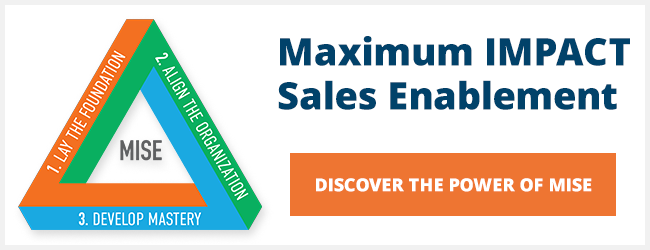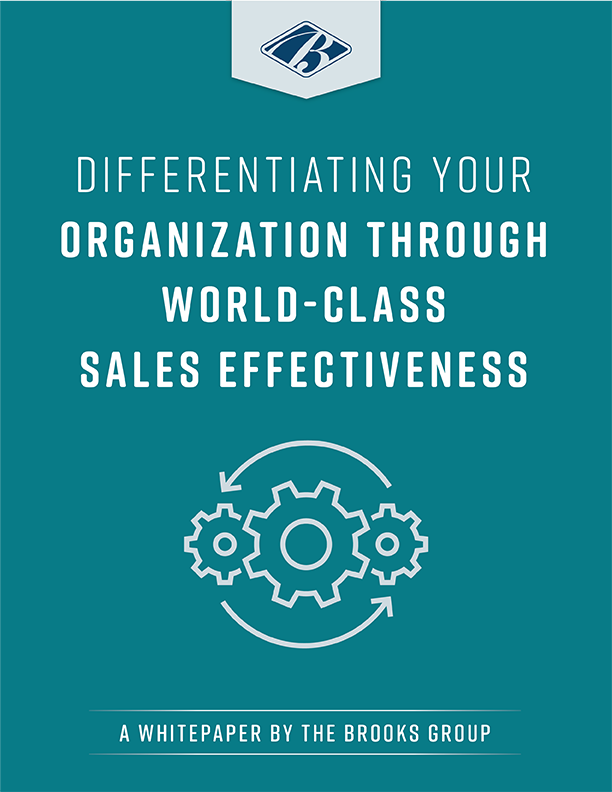The pace of change in the marketplace has never been faster, and there is no sign of it slowing down any time soon. Smart sales organizations prepare for changes in the marketplace so that their teams can perform at the top of their game, no matter what happens next.
Here are the 6 steps to adapting to change that you can’t overlook.
1. Start with a Customer Focus
Nobody knows what is changing for your customers better than your customers. A customer-focused approach enables your sales teams to keep their fingers on the pulse of customer needs and anticipate changes before they occur.
The key to a true customer focus lies in making it more than just a catch phrase. It means:
- Studying and researching your customers and gaining their thought-leadership insights to understand at a deep level what they need and how their businesses are changing
- Training your salespeople to ask probing questions that unearth emerging trends and new information about how customers do business and make purchases—and what influences those decisions
- Using a consultative sales process that builds trust and establishes clear communication with prospects and customers.
To be fully effective, customer-centric selling should go beyond the sales department – to your customer service, marketing, and account management teams as well.
When you have a customer-focused company, you’ll not only adapt more quickly to changes in the marketplace, you’ll also gain customer loyalty, improve retention rates, and increase referrals – making it a win-win for both you and your clients.
2. Recognize the Early Warning Signs of Change
Sometimes important changes in the marketplace seem to pop up overnight. If you’re not paying attention, they can creep up on you and your team and leave you struggling to adapt.
Be prepared by watching for early warning signs, which may include:
- Stagnating sales, without a clear explanation
- Losing more often to a particular competitor or competitive option
- Slower return on marketing dollars
- Longer sales cycles
- Increased pushback on price from prospects and customers
- Complaints from salespeople that prospects are becoming more resistant and harder to hook
- Challenges occurring for your reps in the same stage of the sales process
3. Monitor the Competition with an Innovation Mindset
Sometimes, a competitor may notice a change in the marketplace before you and adapt their offerings. Monitor your primary competitors and watch closely for changes and innovations in the way they market, sell, package, or offer their products.
When you see innovations embraced by the competition, take a close look at what’s driving those innovations to determine whether you’d be wise to adapt along with them.
Tip: Assign each of your sales reps a competitor to monitor and have them share findings during your sales team meetings. You can also coach them to conduct a competitor analysis using this blog post.
4. Identify Strength and Gap Areas of Your Team
As the market shifts, the competencies required for success in your roles may shift as well. Take this time to assess your current team and uncover where they excel, and where they have room for improvement.
The Sales Team Analysis Report is a powerful tool for accomplishing just that. The tool is designed to provide insight into the behavioral makeup of your sales team.
The results of the report will uncover:
- The best ways to structure your team
- Who’s an ideal fit (and who’s not) for your evolving selling environment or position
- Ideal recommendations for training and coaching to help your organization improve overall sales performance in a changing marketplace
5. Schedule Regular Training
Change is hard, but it’s only becoming more common. According to HR Magazine, 86% percent change leaders surveyed expect the number of change initiatives in their organizations to increase over the next two years.
To keep up with the fast pace of change your organization must adapt a growth mindset and conduct regular training. Begin with foundational skills—like a standardized sales process—and then gradually layer on more advanced skills such as strategic account management, territory planning, customer service, etc.
6. Create a Culture of Agility
Ultimately, nobody can predict what will happen in the marketplace, but you can be ready for the unpredictable. A culture of agility enables your team with an attitude and willingness to change that will serve them well in embracing the changes you ask of them.
To develop a culture of agility, start at the top and:
- Hire and train for a mindset of innovation and change
- Communicate the expectation of change and adaptability
- Provide regular training and career development opportunities
- Encourage feedback from your staff on what’s working, where they need help, what’s occurring in the marketplace, and what they believe will move your organization forward
- Constantly analyze data and optimize your processes
In sales, change may be the only constant, but that doesn’t mean you can’t get ahead of it. By following these strategies for adapting to a changing marketplace, your organization can get and stay ahead of the competition, no matter what the future brings.
Partner with a sales training provider who can help you identify where your team is now, and the steps you need to take to grow into the future.
Achieve your short and long-term goals through the 3 phases of Maximum IMPACT Sales Enablement.
Differentiating Your Organization Through World-Class Sales Effectiveness
Is it possible to use your sales team to set your organization apart from the competition? The answer is yes—as long as you’re taking the steps to empower your salespeople and set them up for success. This whitepaper will show you how.






